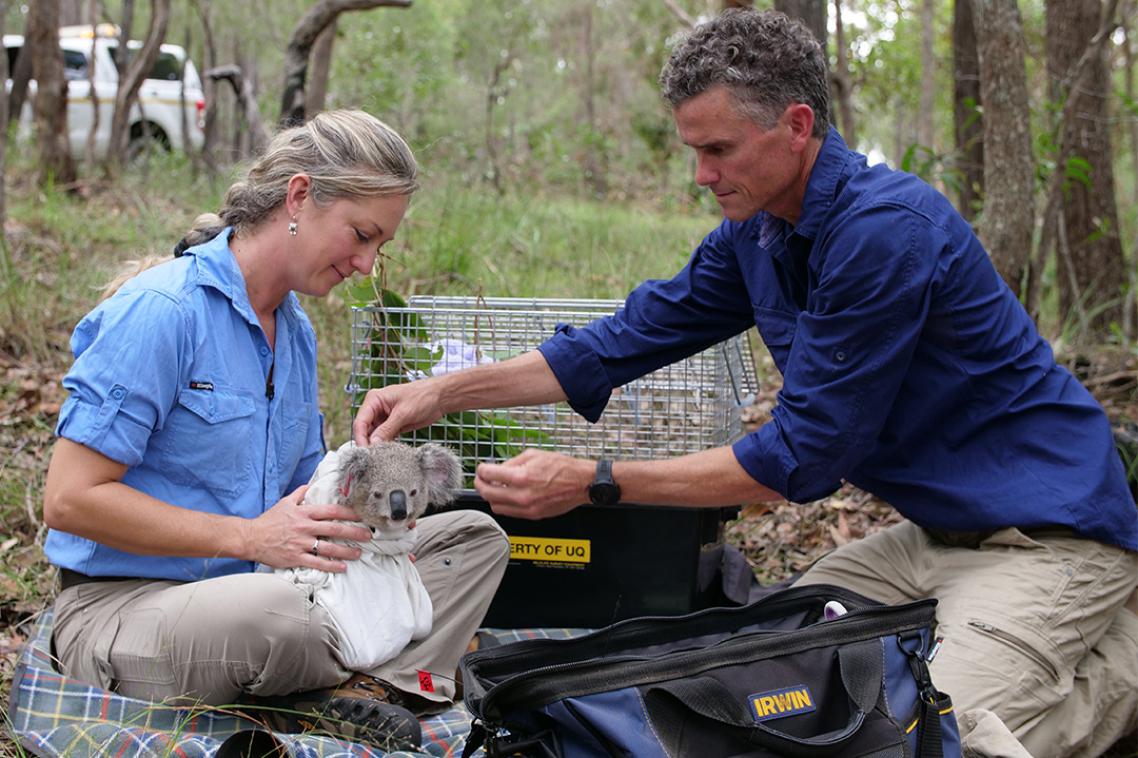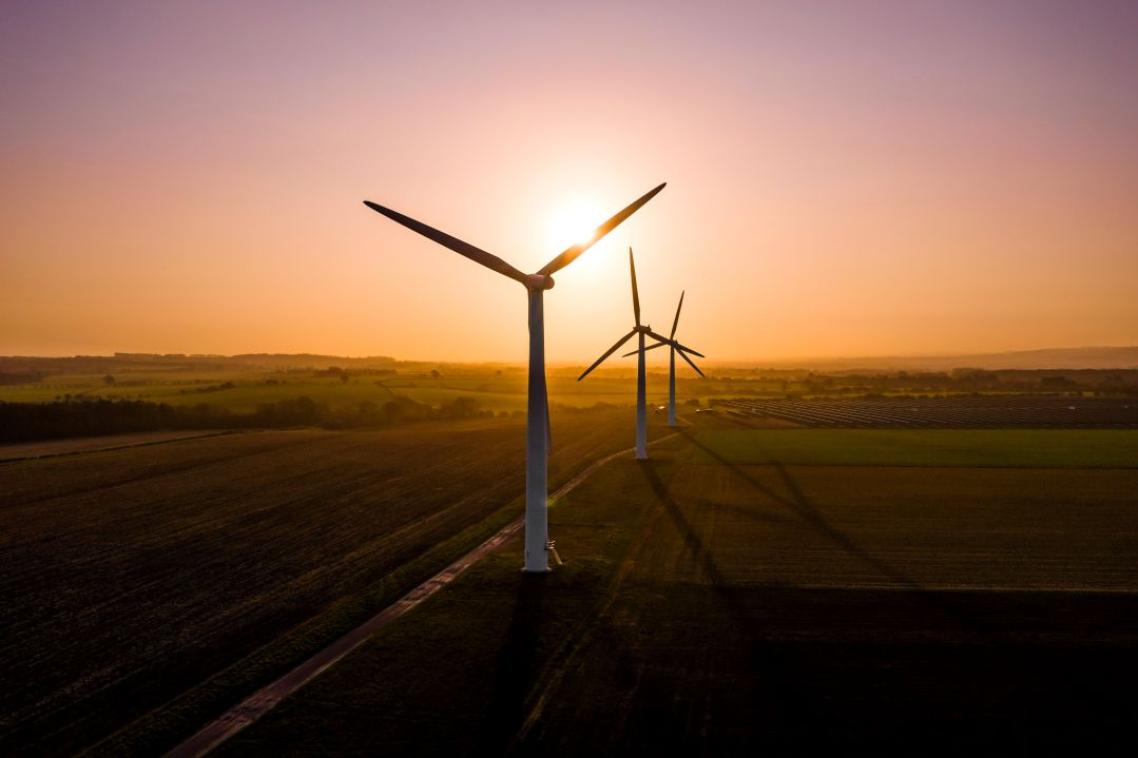Taking the clinic to koalas to beat chlamydia and population decline

Dr Gillett and Dr FitzGibbon fit a koala with a tracking collar before release.
(Photo credit: The University of Queensland )
More than 600,000 Queensland koalas were killed for their fur in August 1927, and almost 100 years on, populations are yet to recover, according to University of Queensland academics.
“Hunting was definitely one of the big threats to koalas and it's well documented there were millions of koalas targeted,” UQ research fellow Dr Amber Gillett said.
“It most definitely led to localised extinctions and would have dropped the national population dramatically.
“We are still on the back foot trying to recover from the hunting and now chlamydia is in the picture.”
The researchers are developing a thorough understanding of the territory of each koala.
(Photo credit: The University of Queensland)
Dr Gillett from UQ’s School of the Environment is part of a team of researchers on the forefront of saving koalas from their next biggest threat.
“Chlamydia is a disease that can decimate populations and it's a silent threat because unless people are out looking for sick koalas, they can end up in a terrible condition,” Dr Gillett said.
“Some of these animals might have been suffering for months or potentially years by the time they get veterinary assistance and sadly some individuals are too sick to be saved.”
Chlamydiosis causes extreme conjunctivitis that can render koalas blind, bladder infections and infertility.
To prevent koalas suffering the decimating effects of disease, a UQ program is proactively checking the health of a South East Queensland population in a bid to rid it of chlamydia.
In the first phase of the program, researchers are focused on the Brisbane Koala Bushlands at Burbank in the city’s south-east where numbers have declined due to high rates of the infection.
The field-based research program is a collaboration with the Brisbane City Council, the Queensland government, wildlife rescue groups and animal hospitals.
New strategy, the solution
Dr Sean FitzGibbon from the Koala Ecology Group in UQ’s School of the Environment said a proactive and multi-agency approach to conserving koalas had been needed for decades to help rebuild populations facing numerous challenges.
“It’s time to try something new in koala conservation because old strategies are failing the species, which continues to decline in many areas,” Dr FitzGibbon said
(Photo credit: The University of Queensland)
“Our program will rapidly improve the health and reproductive capacity of declining populations by intensive disease management and supplementation with healthy youngsters."
The UQ team uses thermal-imaging drones to search for koalas in the reserve. Dr Gillett then examines the koalas in an airconditioned caravan, which is retrofitted as her portable consultation room.
“Captured koalas are given a thorough health examination while briefly anaesthetised, including an ultrasound,” Dr Gillett said.
(Photo credit: The University of Queensland)
“We can determine really quickly if that animal is going to need to go into care for treatment or whether we can release it straight back into the environment.
“That is so much less stressful for a koala than to be caught, popped in a cage, taken to a hospital and maybe spend overnight just to have a clean bill of health before it's released.”
Healthy koalas are rereleased wearing innovative tracking collars so their movements can be monitored daily on an app instead of requiring researchers to walk through bushland with an antenna and receiver.
Dr Ben Barth works alongside Dr Gillett and Dr FitzGibbon as part of the project.
(Photo credit: The University of Queensland)
“We can see how far the koalas are travelling, which could indicate if they are unwell or injured if their movement is limited,” Dr FitzGibbon said.
To enhance the reproductive potential of the population, the researchers have also released healthy sub-adult koalas rescued from elsewhere in Brisbane where their biggest threats include cars and dogs.
Six koalas have been relocated as part of the program, which has led to the birth of a healthy joey.

Samantha has given birth to a joey within 8 months of being relocated.
(Photo credit: Dr Sean FitzGibbon)
“We couldn’t believe our eyes when we saw the little joey who looked only a few days old,” Dr FitzGibbon said.
“The birth of this joey is further proof this strategy works."
Several koalas have been examined and a male named Fudge was returned to his former location after successful treatment for a significant chlamydia infection.
A trial chlamydia vaccine developed at Queensland University of Technology is also being administered to koalas as part of the project.
It is hoped the vaccine will provide additional protective measures to prevent debilitating disease and infertility from chlamydia infection.
“We will never eliminate chlamydia entirely because populations are connected and infected individuals can bring it back in,” Dr Gillett said.
“But through our intensive management over the next 3 years, we expect to once again see a healthy and abundant koala population at Burbank.”
Commonsense collaboration
Dr Gillett holds a unique position on the ecology project, bringing her expertise in native animal medical knowledge to support the team working in the field.
(Photo credit: The University of Queensland)
“Historically, vets are only involved when animals are brought to us for health assessments if the ecology team feels it’s needed,” Dr Gillett said.
“Being here on the ground at the time when we catch the koala has a lot of benefits as I can see the catch process and identify injury or disease even before the health assessment starts.
“The other real benefit is that I can bring with me all of the things that I have in a veterinary clinic.”
Working with koalas is a lifelong dream for the wildlife vet who became enamoured with native animals from a young age.
“From a medical perspective, koalas really keep you on your toes because they’re so unique,” Dr Gillett said.
“But personally, anyone who works with koalas understands how much they can get inside your heart because they each have their own personalities.”
1 of 2 young female koalas being assessed ahead of their release into new habitat from a highly populated area.
(Photo credit: The University of Queensland)
The UQ academic has also worked at The Australia Zoo Wildlife Hospital for almost 20 years.
Her love for koalas isn’t just one she shares with her colleagues but also her partner Dr FitzGibbon who she met at a koala conference.
“We're really lucky,” she said.
(Photo credit: The University of Queensland)
(Photo credit: The University of Queensland)
“Our work is exciting and vibrant and fantastic and takes us to all different parts of the country sometimes.
“We've got a wonderful relationship that allows us to work together, get along so well together, and then still live our home lives as well.”
Dr FitzGibbon said he had great respect for Dr Gillett’s veterinary knowledge.
“Amber is one of the gurus of koala veterinary care in Australia and a lot of people turn to her for advice so it fills me with confidence to have her involved in our projects,” Dr FitzGibbon said.
“Together, we are really passionate about conserving the iconic Australian species for our daughter’s generation and for generations to come.”
Koala sits in a tree after being released.
(Photo credit: The University of Queensland)
Related articles

Brazil claims to be an environmental leader. Are they?

COP30 climate summit: UQ experts
Media contact
UQ Communications
communications@uq.edu.au
+61 429 056 139
